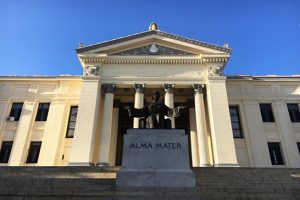
From the February 2017 Desktop News | Michael Wood, an instructor in the Department of American Studies, recently received the North American Society for Sport History’s inaugural Joseph L. Arbena Award, which offers $1,000 to those pursuing research in Latin American sports history.
Wood studies the history of American football in Cuba, and using the funds from the award, he traveled to Havana, Cuba, for eight days to search through archives at the University of Havana and the José Martí Cuban National Library.
“The whole research process is kind of like putting together a jigsaw puzzle when you don’t have the picture and some of the pieces are missing,” Wood said. “It’s kind of hit and miss.”
However, Wood has pieced together that football was largely introduced to Cuba during the U.S. occupation of Cuba following the Spanish-American War. During that time, various units of the military would play against each other in small pick-up games, and in the years following the interest in football grew as Cubans returned from the United States and started gridiron squads at the University of Havana and in Havana-area social athletic clubs.
In addition to games played locally, U.S. and Cuban teams played against each other on 62 occasions from 1907 to 1956.
“At its prime, Cuban football was like division three football in the United States,” Wood said. “There were some instances where the games would draw crowds of 10,000 or 12,000, but for the most part the international games were small, drawing about 2,000 to 5,000 spectators.”
Wood has found documentation of games between Cuban squads and everyone from Louisiana State University to Tulane, Ole Miss, Mississippi State, and a handful of schools in Florida. In 1946, the University of Havana even played The University of Alabama’s B Team in Dothan.
Cuba teams were most competitive in the early years, but football did not gain mass popularity like baseball, and the Cuban Revolution in 1959 marked the sport’s end on the island.
“After the revolution, private athletic clubs were outlawed and liquidated because it was considered a part of privilege, class, and racial exclusion—all things the revolution sought to combat,” Wood said. “The institutions that played American football disappeared, and in 1961, all Cuban sports were reorganized under state control. From that point on, all sports teams were geared toward international play like the Olympics and the PanAmerican Games.”
While in Cuba, Wood was also able to meet Félix Julio Alfonso Lopez, a sports historian whom Wood met in October for the 2016 Cuba week at UA. Lopez’s research focuses on the history of baseball in Cuba, which shares some similarities with the history of football in the country.
Wood will defend his dissertation research, which covers Cuban football from 1907 to 1933, at Texas Christian University in March, but he is already talking to editors about expanding his research for a book that will lay out a transnational analysis of U.S-Cuban football games during the Cuban republican period—and eventually he would like to write a biography on James Kendrigan, the athletic director of the University of Havana from 1923 to 1953.